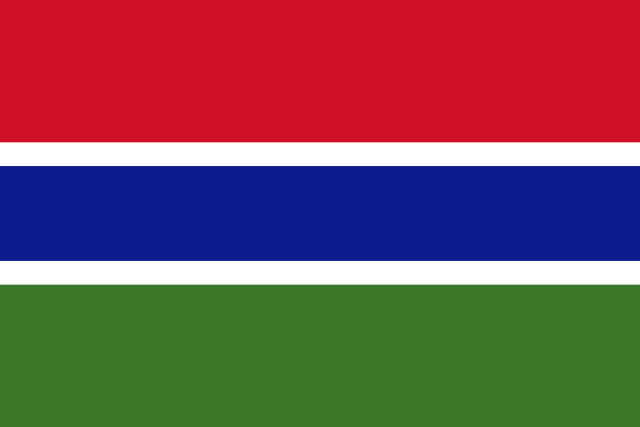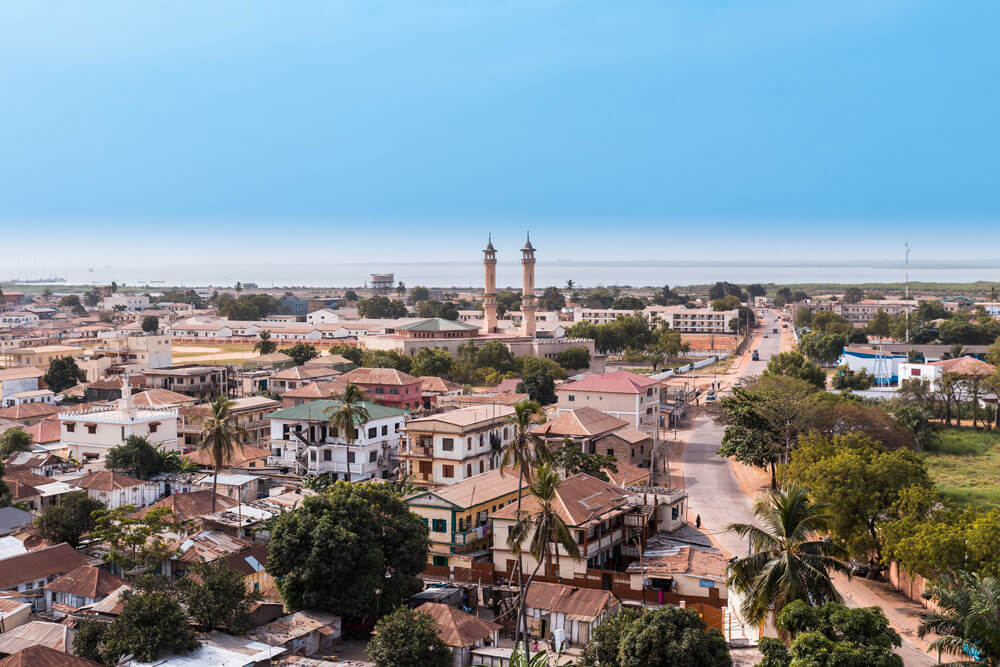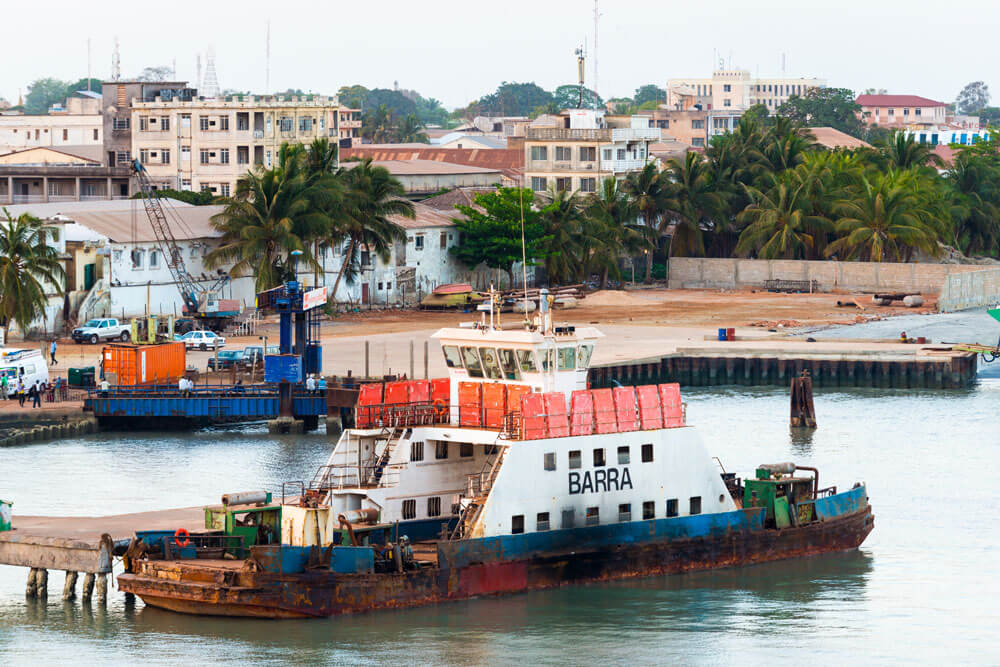The Gambia

Capital city: Banjul
Population: 2.45 million (2021)
Land area: 11,300 km²
Official language: English
Legal system: English law, customary law, Islamic/Shari’a law
Time zone: UTC (GMT)
Currency: Gambian Dalasi (GMD)
GDP: 2.04 USD Billion (2021 est.)
Main industries: Tourism, Manufacturing, Agro-processing, Livestock, Mining
Principal exports: Peanuts, Fish, Cotton, Coconuts, Timber
Gained independence: 1965
Rejoined Commonwealth: 2018
The Gambia is a West African country bordered by Senegal to the north, east and south, and the Atlantic Ocean to the west. It is the smallest country on mainland Africa, with an area of just 11,295 square kilometers, but also happens to amongst the most densely populated in the region. The capital, Banjul, is located on the eastern coastline of the nation, overlooking the Atlantic Ocean.
The Gambia is crossed by several rivers, most notably the Gambia River, which runs through the center of the country and is an important source of water, aquaculture and transportation. The country also has a small coastline along the Atlantic Ocean to the west. The Gambia is known for its diverse ecosystems, including savanna, mangrove swamps, and tropical rainforests. The country is home to several national parks and nature reserves, including the Abuko Nature Reserve and the Kiang West National Park.

Demographics
In 2021, the nation was recorded, by the World Bank, to have a population of 2.64 million. 33.3% of the population belong to the West African ethnic group Mandinka, the largest subgroup of the Mandé peoples; 18.2% belong to the Fulani, Tukulur and Lorobo groups, all of which also hail from West Africa as well as parts of Central Africa; 12.9% are from the Wolof group which comprises the majority of the Senegalese population but is a minority in The Gambia; 11% are the Jola people; 10% belong to the Serahuleh and Serer groups. In terms of religious practice, majority of the population, approximately 96.4%, are Muslim and 3.5% are Christian whilst the remaining population comprise of other religions including Hinduism and Judaism.
English is the official language of the nation taught in most schools, however the more common vernaculars and lingua francae include Mandinka, Wolof and Fula. In terms of population distribution, the largest settlements reside along the Gambia River particularly in the capital city of Banjul and Serekunda, the largest city in size; 64.5% of the population reside in urban areas. The Gambia has a high birth rate of 2.23% which explains its youthful population 39% of which is of 14 years of age or below.
History
The pre-colonial history of The Gambia has been passed down through oral traditions and is closely intertwined with the history of neighboring Senegal. Prior to the late 19th century, the region was commonly referred to as Senegambia and was not yet distinguished as separate entities. The kingdoms of Malinke and Wolof, which were established by the 19th century, were still developing when Alvise Ca’ da Mosto, a Venetian explorer in the service of Portugal’s Prince Henry the Navigator, arrived in 1455. The Malinke were located in the westernmost region of the old Mali Empire, while the Wolof likely migrated from Songhai regions and the Fulani pastoralists were part of a migration from Futa Toro. Despite their local power, none of the small Gambian kingdoms were strong enough to dominate Senegambia, and ongoing internal conflicts made it easier for the French and British to take control of the territory.
The Portuguese were the first Europeans to establish trading stations in the Gambia River regions in the late 1400s, but they abandoned them within a century. Other European trading companies, including the English, French, Dutch, Swedish, as well as the Courlanders, were drawn to western Africa in the following two centuries due to trade possibilities. Throughout the 18th century, a struggle for prestige in Senegambia occurred between France and England, even though trade remained minimal and no chartered company turned a profit. This changed in 1816 when Capt. Alexander Grant was dispatched to the region to rebuild a base that would enable the British navy to control the slave trade. He purchased Banjul Island (St. Mary’s) from the king of Kombo then constructed barracks, laid out a town, and established an artillery battery to control river access. With the arrival of traders and workers from Gorée and upriver, the town, which was renamed Bathurst (now Banjul), grew quickly.
The Gambia was governed as part of British West Africa from 1821 to 1843. It became a separate colony with its own governor until 1866, when control was returned to the governor-general at Freetown, Sierra Leone, where it remained until 1889. Following British domination of the riverine areas, their control seemed certain by 1857. However, a new form of imperialism emerged as peanut cultivation in Senegal grew in importance. By 1880, France had gained control of Senegal. During the 1870s, the British attempted to trade The Gambia to France twice, but were unsuccessful due to opposition both domestically and within the territory. In addition, the Soninke-Marabout Wars caused religious conflicts that lasted for over fifty years and complicated matters further. Although a Muslim leader named Maba had emerged, who could have united the various kingdoms, he was killed in 1864. By 1880, the religious aspect of the conflicts had diminished, and war chiefs such as Musa Mollah, Fodi Silla, and Fodi Kabba continued the battles.
Following a conference in Paris in 1889, France gave up control of the Gambia River to Britain, which established the present-day boundaries of the Gambia. In 1894, Britain imposed indirect rule on the interior, which was divided into 35 chiefdoms, each with its own chief. The real power was held by the British governor and his staff at Bathurst. After its separation from Sierra Leone, the Gambia enjoyed peace, except for some trouble with slave-raiding chiefs. Slavery was abolished throughout the protectorate in 1906. During World War II, the Gambia contributed soldiers to the Burmese campaign and served as an air-staging post. Political parties were slow to develop, but by 1960, several were demanding independence. Britain believed that the Gambia would eventually merge with Senegal and gave the territory revised constitutions in 1954, 1960, and 1962, finally granting it independence within the Commonwealth in February 1965. The Gambia became a republic on April 24, 1970, with Sir Dawda Jawara, the head of the People’s Progressive Party (PPP), as its first president. In 1981, an attempted coup was put down with the help of Senegalese troops after heavy fighting in Banjul. In the aftermath, leaders of both countries created the confederation of Senegambia, which allowed for each state to retain independence in most areas, while integrating military and economic resources. However, the confederation was dissolved in 1989.
During the early 1980s, The Gambia experienced severe economic problems, with foreign donors refusing aid requests, and food and fuel shortages affecting Banjul and rural areas. As a response, the government implemented austerity measures and reforms in 1985, which aimed to bring the country to a more disciplined fiscal and monetary policy. The reform program brought about a positive economic outlook and led to the return of foreign assistance, but for the vast majority of peasant farmers, their economic condition remained dire, with poor harvests and falling peanut prices throughout the decade. Despite this, President Jawara and the People’s Progressive Party (PPP) won the 1987 and 1992 elections easily, though opposition parties made some gains in each election.
Key Dates
Late 1400s- Portuguese establish trading stations in the Gambia River regions
1588- English establish first trading post at Albreda
1661- Dutch establish a trading post on the River Gambia
1816- British reestablish control over the Gambia to combat the slave trade
1821-1843- The Gambia is administered as a part of British West Africa
1866- Control of The Gambia is returned to the governor-general at Freetown, Sierra Leone
1889- France cedes control of the Gambia River to Britain, and the present-day boundaries of The Gambia are drawn
1894- Britain establishes a protectorate in the interior of The Gambia, dividing it into 35 chiefdoms
1965- The Gambia gains independence from Britain within the Commonwealth
1970- The Gambia becomes a republic; former President Dawda Jawara of the Peoples Progressive Party becomes Prime Minister
1982- Loose confederation, Senegambia, comprising Senegal and Gambia, formed
1989– Senegambia scrapped
2013- The Gambia withdraws from The Commonwealth
2018- The Gambia rejoins The Commonwealth
Legal System and Government
The Gambia is a presidential republic with a multi-party system. The President serves as both the head of state and the head of government. The President is elected by popular vote for a term of five years and can serve a maximum of two terms. The National Assembly is the legislative branch of government, consisting of 58 members. 53 members are elected by popular vote, while the other five are appointed by the President.
The legal system of The Gambia is based on the English common law and is also influenced by customary law, which is practiced mainly in rural areas, and the Shari’a law administered by a Cadi Court system. The Gambia has a hierarchical court system consisting of the Supreme Court, the Court of Appeal, the High Court, the District Tribunal, and the Area Tribunal. The Supreme Court is the highest court in the land and hears appeals from the Court of Appeal. The Court of Appeal hears appeals from the High Court and other lower courts. The High Court is the main court of first instance and has unlimited jurisdiction in both civil and criminal matters.
The District Tribunal and the Area Tribunal are lower courts that deal with minor civil and criminal cases. The District Tribunal is presided over by a magistrate, while the Area Tribunal is presided over by a village head. In addition to the formal court system, there are also customary courts, which are presided over by village elders and chiefs. These courts handle disputes related to traditional practices, such as land disputes, inheritance, and marital issues. Customary courts are not recognized by the formal legal system, but they play an important role in the lives of rural communities.

Economy
Currently, The Gambia is a low-income country with Least Developed Country (LDC) status. The mixed economic system of The Gambia is heavily reliant on the agricultural sector, re-exports, tourism and overseas remittances.
According to 2019 estimates, agriculture, forestry and fishing contribute 22.4% of GDP and employs 27% of the labour force directly although 60% of the population depends on the sector directly and indirectly for their livelihood. The agricultural sector is predominantly focused on rain-fed subsistence farming of food crops including cereals such as millet (both early and late), sorghum and rice; some cash crop production, of groundnuts, cotton, sesame and other horticulture, is also common. The crops sub sector feeds 50% of the population and generates 40% of foreign exchange earnings. Although the nation has one of the richest fishing zones in the world with total continental shelf area of 3855 sq.km, the sector is rather under-exploited and according to a report published by a High-Level Panel for a Sustainable Ocean Economy, The Gambia is sustaining heavy monetary losses due to illegal fishing; a 2018 pact with Senegal allowing them access to Gambian water has also resulted in loss of small pelagic fish catches.
The industrial sector contributes 17.2% to GDP and employs 15% of the labour force. Gambian industries primarily specialise in livestock, agricultural processing, horticulture and construction; manufacturing comprises 2% (of GDP) of the industrial sector’s GDP contribution mainly due to local SMEs that produce commodities to match domestic needs. The services sector is the most prevalent, making up 53.3% of GDP and employing 58% of the working population. The services sector is dominated by the tourism industry, infrastructural development services and the public sector. Re-exports constitute 70% of the country’s total exports largely comprising of machinery and mechanical appliances.
Trade
In 2021, The Gambia’s GDP was recorded at US$2.04 billion. The nation exported US$27.9 million worth of merchandise, the top products of which included machinery, mechanical appliances, reactors, boilers and parts thereof (44.7%), salt, Sulphur, earths, stone and plastering materials (19.5%), fish and crustaceans; molluscs and other aquatic invertebrates (5.5%) and animal/vegetable fats, oils and their cleavage products (3.9%). The main destination markets included Mali (44.7%), China (29.1%), Senegal (10.9%) and Guinea-Bassau (4.5%). In terms of imports, The Gambia’s import expense for 2021 amounted to 708.9 million largely due to the importing of mineral fuel, oils and products of their distillation (38.5%), vehicles other than tramway/railway rolling stock (10.6%), cereals (7.9%) and salt, sulphur, earths, stone and plastering materials (3.9%). These were largely sourced from Togo (15.4%), Côte d’Ivoire (12.4%), China (7.6%) and Denmark (6.0%).
The Gambia is a member of the Economic Community of West African States (ECOWAS) and is a ratifying member of the African Continental Free Trade Area. The nation has bilateral investment treaties with Turkey, Morocco, The Netherlands, Qatar and Switzerland.
Investment Opportunities
The Gambia is a peaceful and politically stable country, ranking 45th on the Global Peace Index in 2022, with a youthful and cost-effective skilled/semi-skilled labour force that ranks 41 of 138 on the Labour Market Efficiency Index. The liberalised economy offers a business friendly environment with a flexible exchange rate, reliable laws and a geostrategic location that provides access to the rapidly growing West African market with over 300 million potential consumers and also provides port access to shipping from the Atlantic Ocean.
The Government’s National Export Strategy 2021-2025 is a roadmap to the nation’s goal of export diversification and growth to recalibrate the economy towards the advanced economic sectors and position it well on global value chains. The Information and Communications Technology (ICT) sector is a priority sector considering the impressive growth of the sector in the past 2 decades with internet penetration going from 5% to 50% since the year 2000. The sector is also a focus under the National Development Plan as the government aims to establish national data centres connected to schools and public institutions, increase internet and mobile phone usage, upgrade telecommunications infrastructure, strengthen cybersecurity and build a National Technology Park amongst other initiatives. Another top priority for the government is the generation of reliable, stable and clean energy and due to the nation’s geographical location, solar power is an ideal source of power; many large scale projects including the (REPGam) project and The Gambia Sustainable Energy Sector Program can be availed by foreign investors. The nation’s strategic location has also incentivized focus on developing transport infrastructure to make the country a transport hub for the West African region with several projects underway to improve road, port and air transport service. For example, The Port of Banjul, managed and operated by The Gambia Ports Authority, is set to become one of the world’s busiest shipping lanes to International Shipping Traffic with the capacity to handle up to 1.5 million tonnes of cargo annually.
With a steadily increasing urban population, growing middle class and increasing tourism in the face of the rebound from the COVID-19 pandemic, The Gambia is well placed to capitalise on investments to develop the over 550,000 hectares worth of arable land with the most promising opportunities in horticulture, rice, poultry, livestock, fisheries and agricultural inputs. Along with Tourism, Agribusiness and Horticulture, Fisheries, Ground Nuts and Cashews, light manufacturing is a priority strategic sector under the National Export Strategy as a pathway to reduce reliance on imports. Targeted products to develop include clothing apparel, iron and steel, soaps, plastics and timbre products.
The Gambian government distributes Special Investment Certificates (SICs) as its main investment promotion scheme for both domestic and foreign invetsors; if they invest a minimum of, respectively, $100,000 and $250,000 in a priority sector and/or in a priority area, employ a minimum number of Gambians set by the regulations, or create value addition, they are legible for incentives including income tax exemptions for upto 5 years, annual allowance at the rate of 15% for depreciation of buildings, including structural improvements and notwithstanding the rate provided in Schedule III of the Income and Value Added Tax Act (2012). Investors are also exempted from import duty on capital goods and exempt from import VAT for upto 5 years.
Sources
https://www.britannica.com/place/The-Gambia/
https://www.cia.gov/the-world-factbook/countries/gambia-the/
https://www.bbc.com/news/world-africa-13380407
https://move.gambiaembassy.eu/the-gambia/state-government/
https://www.un.org/ohrlls/content/list-ldcs
https://www.worldbank.org/en/country/gambia/overview
https://www.aa.com.tr/en/africa/fish-scarcity-hits-the-gambia-affecting-livelihoods/2042343
https://www.trade.gov/country-commercial-guides/gambia-market-overview
https://www.trade.gov/country-commercial-guides/gambia-agriculture
https://www.wto.org/english/tratop_e/tpr_e/s233_sum_e.pdf
https://data.worldbank.org/indicator
http://rtais.wto.org/UI/PublicSearchByMemberResult.aspx?MemberCode=270&lang=1&redirect=1
https://investmentpolicy.unctad.org/international-investment-agreements/countries/76/gambia
https://countryeconomy.com/demography/global-peace-index/gambia